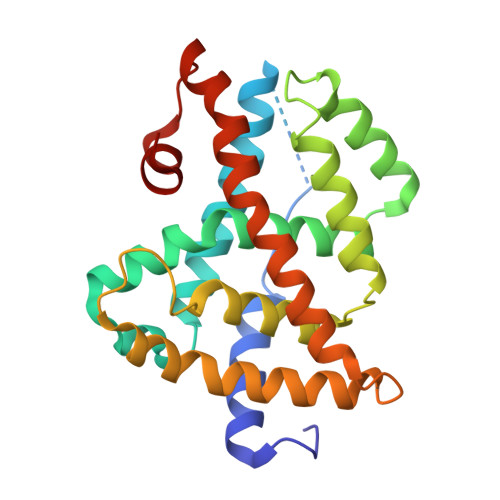A chemical, genetic, and structural analysis of the nuclear bile acid receptor FXR
Downes, M., Verdecia, M.A., Roecker, A.J., Hughes, R., Hogenesch, J.B., Kast-Woelbern, H.R., Bowman, M.E., Ferrer, J.-L., Anisfeld, A.M., Edwards, P.A., Rosenfeld, J.M., Alvarez, J.G., Noel, J.P., Nicolaou, K.C., Evans, R.M.(2003) Mol Cell 11: 1079-1092
- PubMed: 12718892
- DOI: https://doi.org/10.1016/s1097-2765(03)00104-7
- Primary Citation of Related Structures:
1OSH - PubMed Abstract:
The farnesoid X receptor (FXR) functions as a bile acid (BA) sensor coordinating cholesterol metabolism, lipid homeostasis, and absorption of dietary fats and vitamins. However, BAs are poor reagents for characterizing FXR functions due to multiple receptor independent properties. Accordingly, using combinatorial chemistry we evolved a small molecule agonist termed fexaramine with 100-fold increased affinity relative to natural compounds. Gene-profiling experiments conducted in hepatocytes with FXR-specific fexaramine versus the primary BA chenodeoxycholic acid (CDCA) produced remarkably distinct genomic targets. Highly diffracting cocrystals (1.78 A) of fexaramine bound to the ligand binding domain of FXR revealed the agonist sequestered in a 726 A(3) hydrophobic cavity and suggest a mechanistic basis for the initial step in the BA signaling pathway. The discovery of fexaramine will allow us to unravel the FXR genetic network from the BA network and selectively manipulate components of the cholesterol pathway that may be useful in treating cholesterol-related human diseases.
Organizational Affiliation:
Howard Hughes Medical Institute, Gene Expression Laboratory, 10010 North Torrey Pines Road, La Jolla, California 92037, USA.















